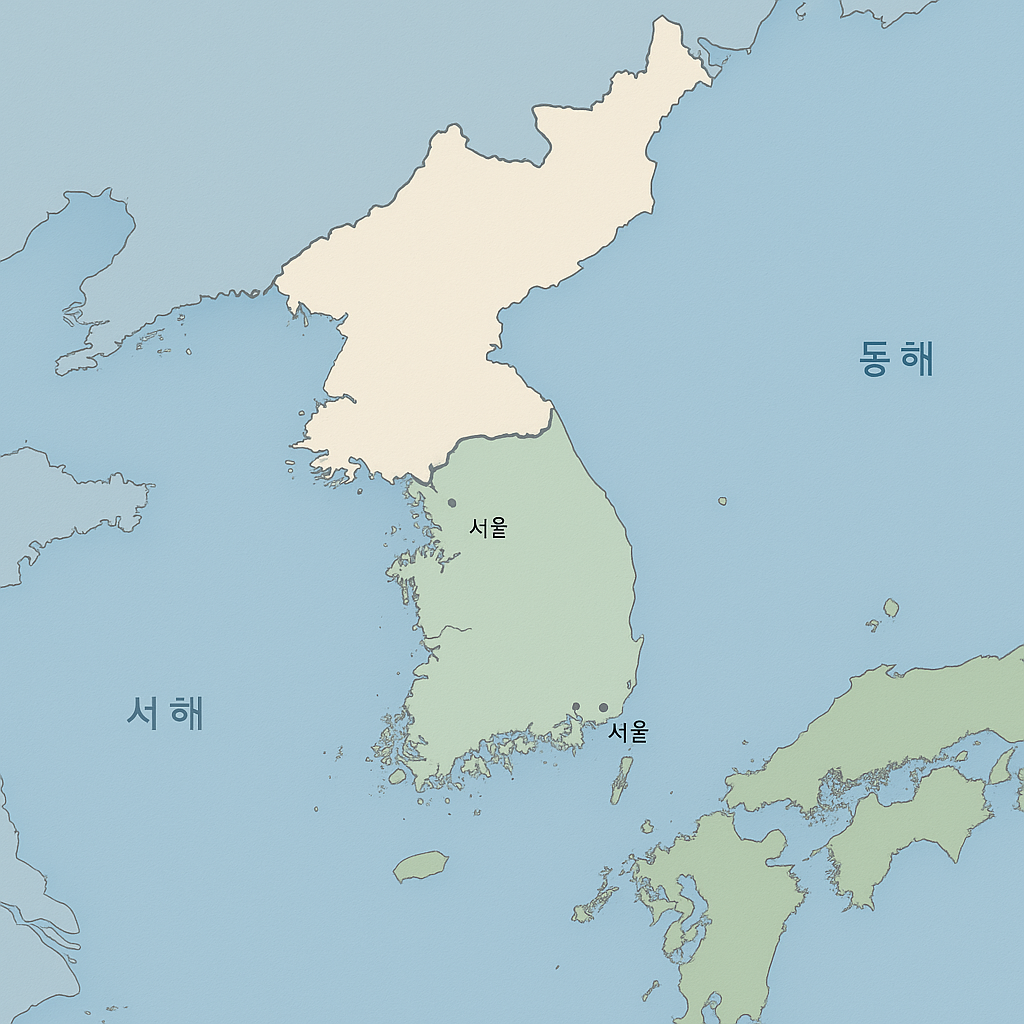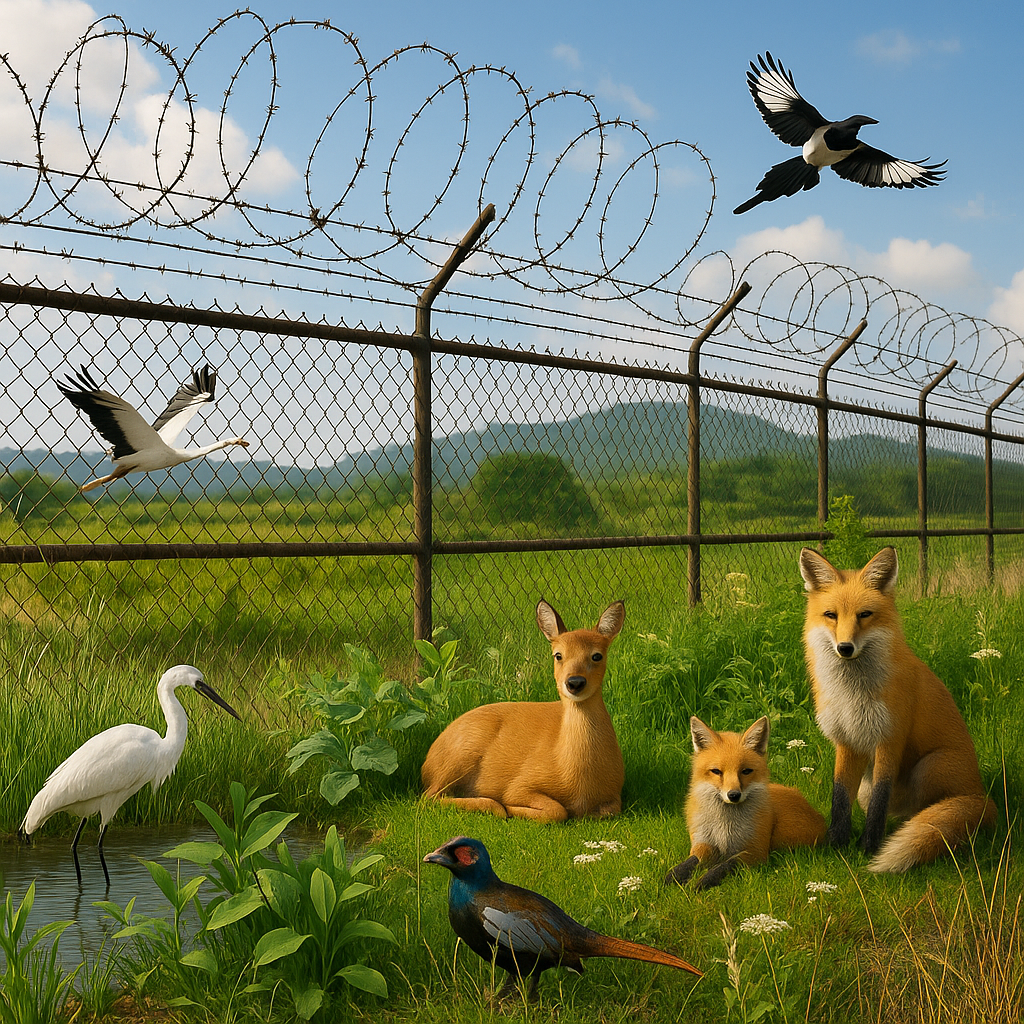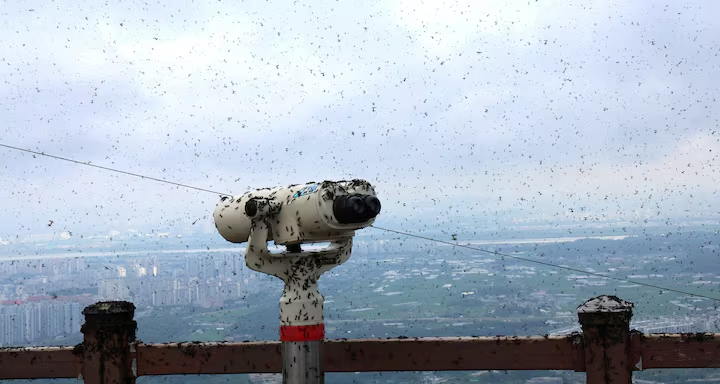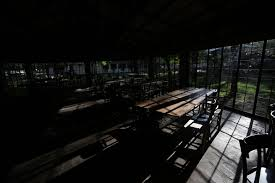| 최초 작성일 : 2025-08-21 | 수정일 : 2025-08-21 | 조회수 : 34 |

On August 21, 2025, The Guardian presented a story that is as unsettling as it is remarkable. Opening with the paradoxical line, “Landmines have become the greatest protectors,” the article reveals that the Korean Demilitarized Zone (DMZ)—long seen as a scar of war and division—has become an unlikely ecological haven. Within this narrow strip of land, more than 6,000 species, including endangered ones such as the red-crowned crane, musk deer, and tiger shrike, are thriving. What was once designed as a buffer of hostility has, through the absence of human presence, evolved into a sanctuary of biodiversity. The DMZ was originally a zone of fear, a reminder of unresolved conflict, and a place avoided by people. Yet precisely because of that fear—and the landmines buried within—the area remained untouched by development. Over decades, this accidental preservation has given rise to one of the most unique ecosystems in the world. The irony is stark: weapons of war have inadvertently safeguarded life. This reality raises profound questions: Does safety come from human laws and systems, or from the absence of human interference? Could the most effective form of conservation be simply leaving nature alone? Such questions transform the DMZ from a mere geopolitical anomaly into a stage for philosophical and ecological reflection. Here, we are witnessing the convergence of danger and protection, destruction and preservation. This blog post takes the DMZ news story as a starting point to revisit Ulrich Beck’s Risk Society theory and the notion of ecological paradoxes, offering fresh insight into how we understand the uneasy relationship between human conflict and natural survival.
1. Ulrich Beck’s Risk Society Theory German sociologist Ulrich Beck, writing in the aftermath of the 1986 Chernobyl disaster, argued in his seminal book Risk Society that the defining feature of modernity is risk. Unlike natural disasters of the past, contemporary risks are predominantly “manufactured risks”—the byproducts of human systems and technologies such as nuclear energy, chemical pollution, military weaponry, and climate change. Beck emphasized that these risks are global in scope, transcending borders and social classes. Polluted air does not recognize national boundaries; greenhouse gases alter the climate worldwide; and military remnants, such as landmines, continue to harm generations long after wars have ended. Thus, in a risk society, the central issue is not the distribution of wealth but the distribution of risks. 2. The Ecological Paradox Environmental sociology often refers to the “ecological paradox”—a situation where destructive forces inadvertently foster preservation. The DMZ exemplifies this paradox. Landmines and military tensions, while designed for deterrence and destruction, have barred human access, creating conditions where ecosystems thrive. This paradox illustrates that the relationship between humans and nature is rarely linear. What we label as “danger” may sometimes serve as protection, while what we consider “conservation” can ironically lead to destruction. Effective environmental policy must therefore grapple with these paradoxes, recognizing that ecological outcomes are often complex and counterintuitive. 3. Sociological Implications From a sociological standpoint, the DMZ is not merely an anomaly but a mirror of risk society’s contradictions. Human-made threats (landmines) have suppressed other forms of human intrusion, enabling biodiversity to flourish. This duality underscores the ambivalence of risk in modern society. Politically and legally, it also reignites fundamental debates about the balance between preservation and security, development and ecological protection.
1. DMZ: A War Legacy Turned into an Ecological Haven The Korean Demilitarized Zone (DMZ) is one of the most militarized and heavily guarded borders in the world. Yet, paradoxically, this very zone has become a sanctuary for biodiversity. Korean media often describe it as “a paradise of nature protected by landmines.” What they mean is that because human access has been strictly prohibited, the DMZ has become a safe refuge for endangered species and rare ecosystems that are disappearing elsewhere on the peninsula. This is more than a story of nature’s resilience. It is also a living example of what sociologists call the “Risk Society” and what environmental theorists describe as the “Ecological Paradox.” In short, a weapon of war—landmines—has unintentionally acted as a shield for nature against humanity itself. 2. Risk Society and the Irony of Protection Ulrich Beck’s concept of the Risk Society argues that modernity is defined not by the distribution of wealth, but by the distribution of risks. The DMZ illustrates this principle vividly. On one hand, landmines and the constant threat of military conflict impose immense dangers on human life. Residents near the border live under constant anxiety about violence and displacement. On the other hand, those very risks have unintentionally prevented industrial development, urbanization, and agricultural encroachment. The presence of risk has created a paradoxical buffer zone where nature thrives. This teaches us that risk is not a simple “evil” to be eliminated; it is a double-edged phenomenon that must be understood within its broader social and ecological context. The DMZ demonstrates that risks, though dangerous, can also reshape environments in unexpected ways. They show how unintended consequences of human activity can create conditions that benefit ecosystems, even while harming people. 3. The Ecological Paradox Made Visible Environmental sociology often discusses the Ecological Paradox: the idea that human efforts to dominate or control nature often lead to outcomes opposite of those intended. The DMZ is a striking case. A zone designed for military defense, marked by barbed wire, guard posts, and hidden explosives, has ironically become one of the most biodiverse areas in East Asia. This is not the result of a deliberate conservation policy. Rather, it is the absence of human intrusion—made possible only by danger—that has allowed ecosystems to regenerate. Cranes, otters, bears, and countless migratory birds now thrive where human beings dare not tread. The lesson is sobering: what we achieve through expensive “conservation projects” elsewhere, the DMZ achieves simply because of enforced human absence. In other words, the paradox here is that destruction (weapons of war) has created protection (a sanctuary for nature).

1. Policy-Level Recommendations The ecological paradox of the DMZ offers clear lessons for policymakers. First, the DMZ should not remain merely an “accidental sanctuary.” Instead, it should be deliberately transformed into a Peace Ecology Park or internationally recognized conservation zone. Second, while landmines have unintentionally preserved biodiversity, they continue to pose fatal risks to human life. Therefore, a balanced approach is needed: gradual demining supported by ecological surveys, combined with alternative conservation strategies to ensure that biodiversity is not lost once the physical barriers are removed. 2. Social and Cultural Reflections The DMZ has remained intact because of one simple fact: the absence of humans. This paradox challenges modern society to confront a difficult question: How much are we willing to step back to allow nature to thrive? The lesson here is not just about accidental protection but about intentional restraint. Urban expansion, industrial development, and over-tourism all mirror the destructive patterns the DMZ avoided. In other words, sustainability may demand deliberate human withdrawal, not constant intervention. 3. Global and Intergenerational Significance Finally, the DMZ is not just a Korean story. Around the world, zones of military conflict and restricted access have unexpectedly preserved ecosystems—from the Iron Curtain green belt in Europe to former battlefields that became wetlands. This calls for a new global model of “peace through ecology,” where demilitarized areas serve as both symbols of reconciliation and laboratories for conservation. Moreover, the DMZ reminds us that safeguarding biodiversity is not only an environmental issue but also a question of intergenerational justice—a responsibility we owe to those who will inherit the planet.
The DMZ is one of the world’s most unusual landscapes—born of conflict, yet preserved by absence. Within its boundaries lies a paradoxical question: “If nature thrived because humans stayed away, what role should we play in protecting it now?” Too often, human efforts to “protect” nature come through intervention and control. The DMZ reminds us that sometimes the most powerful act of conservation is restraint—knowing when to step back and allow ecosystems to breathe on their own. What was once a symbol of division has quietly transformed into a sanctuary of life, exposing the contradictions that define modern civilization. The lessons of the DMZ stretch beyond ecology. They speak to the intertwined values of peace, sustainability, justice, and intergenerational responsibility. How we treat this fragile corridor reflects not only our relationship with nature but also our vision for humanity’s future. The task ahead is clear: to turn an accidental miracle into a deliberate commitment. If we succeed, the DMZ will no longer be remembered solely as a scar of war, but as a living textbook of peace and coexistence—a place where the silence of conflict gave way to the voice of nature.














